Revisiting our 2021 prediction
It’s typical at this time of year to both reflect on the year past and to outline our thinking for the year ahead. Having done this many times, I often get quite nervous opening the previous year’s commentary to review what was said and compare to the reality of what unfolded. As I reviewed our views from a year ago, I was pleasantly surprised. By the standards by which these ‘predications’ can deviate from reality we weren’t too far away. To summarise, we made several key observations at the end of 2020:
- Starting yields meant cash and bond returns would be poor in 2021.
- Opportunities to spread risk across the capital structure (broader use of diversifying strategies) would help lift returns and mitigate the need to simply take on more equity risk.
- Volatility would be a feature in 2021.
- Investors needed to keep a close eye on inflation as it would likely rise and put pressure on bond yields.
- The key for equities would be profits: if profits came through then equities could do well given recovering economies and still plentiful policy support. We expected risk assets to remain supported but were cautious on how far to back this trade.
We were nearest to the mark with regards to cash and fixed income returns, perhaps not such a hard one to forecast given the low level of yields, but with Australian composite bonds returning a negative 2.9% for 2021, I’m happy to claim this one. We also used diversifying assets to lift returns, allocating away from cash, sovereign bonds and low risk mortgage-backed securities toward higher yielding private debt and commercial real estate mortgages, securitized debt and insurance linked securities which boosted returns in the low-to-mid-risk part of our portfolios.
Inflation also became a key focus in 2021 as supply chain disruptions, coupled with recovering economies and pro-cyclical economic policy converged leading to US core inflation printing at rates not seen since the early 1990’s (in headline CPI terms not since the early 1980s). While we were directionally right for equities and for the right reasons (strong profits) the extent of the gains in equities were surprising (particularly in the US) – albeit we are starting to see some of these gains abate (half marks for this one). Backing this view with a more aggressive equity allocation would have produced higher returns, it would also have been accompanied by materially higher risk. While volatility was elevated compared to pre-pandemic (say 2019), it’s hard to argue that volatility was a defining feature of 2021. So, a miss here.
Looking forward to 2022
There are several key factors that differentiate 2022 from 2021.
- Rising inflation is no longer a risk but a reality. Central banks will need to begin responding to this in 2022 through both the winding back of quantitative easing and through the cautious lifting of interest rates. The mismatch between nominal growth outcomes and policy settings is extreme and this gap will inevitably close but central banks will need to find a balance between rebalancing policy with the economic uncertainty of the pandemic and the inevitable pressure from markets.
- Both global growth and profit growth will moderate in 2022, not dramatically (we are not forecasting recession) but a slowdown from the heady pace of the “re-opening” of the global economy. We think the risks here are probably to the downside, particularly if the pandemic fails to be managed and shift to endemic soon (Omicron is a timely warning that complacency should be avoided).
- Valuations remain optimistic in key risk assets (very optimistic in US equities). Against a less accommodative policy and growth / profit backdrop, it is highly likely that these valuations will be tested in 2022 – particularly on the back of any negative surprise or disappointment in profits.
- While cash rates remain at or around zero in major markets (including Australia), sovereign bond yields have moved modestly higher, reflecting the tussle between rising inflation and high debt loads that likely limit the extent to which yields can move higher. While we still believe that higher yields (and low fixed income returns) are likely in 2022, this may ebb and flow as economic variability and pressure from markets oscillates.
At the end of the day though what really matters is the decisions we make and how risk is allocated in our portfolios. On this point, it’s very likely that 2022 will be a more challenging year for investors than 2021.
How we’re positioning the portfolio
We expect equities to be an important source of returns over the year, but we also expect overall equity returns to be lower than in 2021 and importantly the path of returns to be more volatile. Having built up our equity exposure in 2021 (peaking at around 37% in October) we have trimmed our exposure materially, going into year end with a more defensive stance, expecting near term volatility to rise as countries struggle to reconcile health and policy settings. Our focus is on markets that have lagged (Asia and other emerging markets) and on companies that can demonstrate genuine growth in earnings over time. Many of the stocks that have benefitted from a “growth at any price” focus (like technology) have been underperforming of late and this may continue for a while. Genuine and sustainable earnings growth will be valuable.
We’ve also been trimming our diversifying asset exposure as we believe valuations for many assets in this space (particularly higher yielding credit) has run its course. The exception from a valuation perspective is Asian credit, which has been buffeted by its connection to Chinese property and looks cheap, albeit not without risk. At the margin, we prefer equities given the potential for upside which is not there in the credit space.
On the defensive side of the ledger, we held low levels of duration for most of 2021 (typically less than 1 year particularly, in the second half) but have recently added back to increase our risk hedges.













